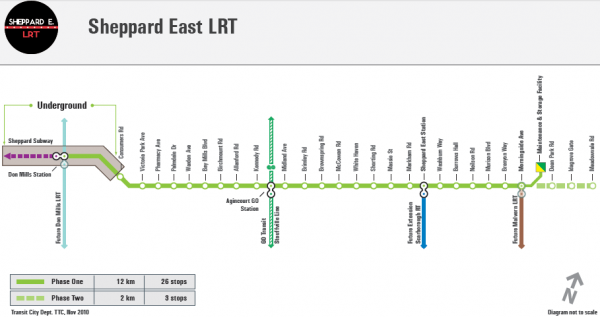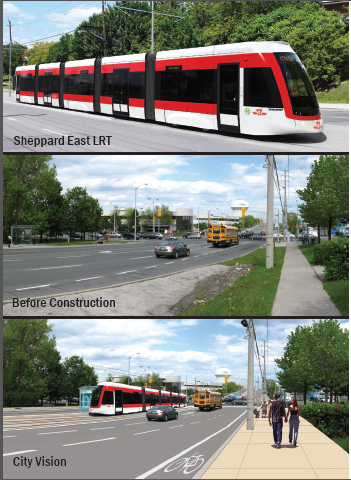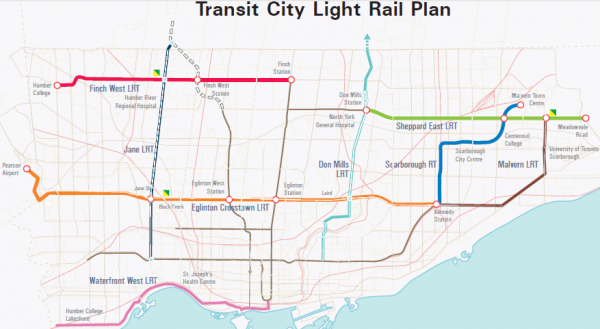
Some major partners involved with the Sheppard Avenue East Light Rail Transit project are:

Also, the Government of Canada, Province of Ontario and City of Toronto are bringing improved transit to North York and Scarborough.
The Sheppard Avenue East Light Rail Transit (LRT) project in Toronto will have the following features:
- A 12km light rail transit for customers to travel on Sheppard Avenue between Don Mills Subway Station and Meadowvale Road
- LRT will enter a tunnel just west of Consumers Road, travel under Highway 404 and connect directly to the subway level at Don Mills Station
- Bus service on Sheppard Avenue East, east of Don Mills Road, will be replaced with environmentally friendly, modern electrically-powered light rail vehicles (made by Bombardier) operating in dedicated transit lanes, at street level in the centre of Sheppard Avenue East, separated from traffic
Transit City is an initiative to build eight new Light Rail Transit lines across Toronto to accommodate population growth and economic development with the following futuristic highlights:
- Transit City routes will be accessible to customers with all levels of mobility
- Provide transit users with a high level of customer service and seamless connections with existing and future transit services
- Bombardier’s Light Rail Vehicles to be used on all Transit City projects will have significant service improvements, including:
- Fast boarding from multiple doors
- Proof of Payment (no tokens)
- Fully accessible
- Travel at 50-60 km/h
- Increased capacity (280 passengers/vehicle)
- zero emissions on the street
- Construction activities have started to build a convenient connection with GO
- Transit at the Agincourt GO station
- The Sheppard East LRT will be completed and service will begin in 2014.

This project will transform Sheppard Avenue East and provide transit users with many improvements and benefits including:
- Reliable and fast service
- Elimination of delays experienced by buses that operate in mixed tra ffic
- Low floor accessible vehicles with barrier free access
- Higher operational speeds of 50-60km per hour
- Increased passenger capacity to reduce crowding
- A convenient fare collection system and all door loading that speeds up passenger boarding
- An integrated underground connection from just west of Consumers Rd to the Sheppard Subway at Don Mills Station
- Decrease commute times
- Reduce reliance on cars
- Conserve energy
- Improve air quality
- Create jobs in the construction and related trades industry
- Support economic development
“Without the ability to move lots of people efficiently and affordably, great cities can’t be great.” This video shows Metrolinx’s plan, The Big Move:
Here is the timeline of the above partners’ actions culminating in the eventual Expert Advisory Panel’s recommendation that Sheppard Avenue East transit to be transformed to the above-ground Light Rail Transit (LRT) rather than the underground subway:
- Metrolinx was created by the Government of Ontario in 2006, to address the urgent need to improve and integrate transportation in the metropolitan region stretching from Hamilton to Durham and north to Lake Simcoe.
- In 2008, Metrolinx published its “The Big Move” (The Big Move: Transforming Transportation in the Greater Toronto and Hamilton Area) regional transit plan, which will involve:
- a $50 billion expenditure on transit over the next twenty-five years
- Metrolinx has indicated that it is currently preparing an investment strategy for funding the plan
- this plan will be provided to the Province in June, 2013
- safer bikeways and pedestrian walkways
- less congested roads
- and a more efficient way to move goods and services
- a $50 billion expenditure on transit over the next twenty-five years
- On May 14, 2009, GO Transit merged with Metrolinx – to build rapid transit projects faster and improve customer service for the traveller in the Greater Toronto and Hamilton Area (GTHA).


- In 2010, Province of Ontario had approved Metrolinx’s “5 in 10 plan”to build five transit projects in ten years.
- The 5 in 10 Plan proposes building the “Big Five” transit projects by 2020, while saving $4 billion in the first five years of the timeline that Metrolinx originally proposed.
- By approving the plan, the Province also allows Metrolinx to sign a contract with Bombardier Inc. to buy light rail vehicles for the TTC to operate along four of Toronto’s Transit City light rail transit (LRT) lines:
- the Sheppard Avenue East LRT,
- Eglinton Crosstown LRT
- Etobicoke – Finch West LRT
- and the Scarborough rapid transit line, after the City of Toronto and TTC have extended the line and converted it to light rail
- Metrolinx is providing funding for the above four priority Transit City projects
- The Province of Ontario, through Metrolinx, has committed to investing $8.4 billion (2010 dollars) in rapid transit projects in the City of Toronto.
- As a provincially funded project, the transit option selected by the City for Sheppard Avenue East will also require the approval of the Province of Ontario.
- The Federal Government has committed $333 million to rapid transit expansion in Toronto under the Building Canada Fund.
- On February 8, 2012, Toronto City Council established an Expert Advisory Panel to assess options for rapid transit along the Sheppard Avenue East corridor.
- A Council decision on Sheppard Avenue East is required to complete Toronto’s input to the Province–which must decide on a timely basis on how best to fully commit available funds and implement construction across all transit expansion lines that were part of the 2010 Metrolinx plan.
- The expert advisory Panel evaluated three public transit options:
- Option A was LRT service from Don Mills to Morningside
- Option B was a subway from Don Mills to Scarborough City Centre, effectively extending the current 4 Sheppard subway lines;
- Option C was a a “hybrid” option — subway from Don Mills to Victoria Park and LRT from there eastward to Morningside
Presently, the recommendations from the panel of transit experts (Expert Advisory Panel) regarding transit on Sheppard Avenue East are summarized as follows:
- Council:
- Confirm that Light Rail Transit(LRT) is the preferred rapid transit mode for Sheppard Avenue East, from Don Mills to Morningside, and confirm the Sheppard Avenue East LRT as a priority transit line within the approved Metrolinx ‘5 in 10 plan’.
- Request the City Manager to develop a communication plan which outlines the significance of transit’s role in city building, on Sheppard Avenue East and across the city.
- Request the province, through Metrolinx, to accelerate the preparation of the investment strategy for the “Big Move” transit expansion plan.
- City Manager develop:
- For Council’s consideration and approval, a comprehensive transit plan, that:
i. is consistent with Metrolinx’s Big Move; ,
ii. integrates equitable economic development and other city-building strategies;
iii. recognizes the context of the current 5 year Official Plan review; and
iv. can ultimately be woven into the City’s Official Plan- A comprehensive public consultation process that provides residents and businesses an opportunity to participate and inform the development of a sustainable transit plan, including funding options, for the City of Toronto.
- An intergovernmental strategy in support of a sustainable transit plan; working with the Federal and Provincial governments (including P3 project delivery), along with appropriate municipal associations (e.g. Federation of Canadian Municipalities (FCM), to seek a commitment to the type of long-term tri-partite funding commitment discussed in this report.
The panel recommended that Council approves light rail transit along the surface of Sheppard East between Don Mills Road and Morningside Avenue for the following real reasons:
- LRT is the most cost effective transit option presented.
- An analysis of the capital investment required for each option on a per rider basis, identified the Subway and Hybrid options to be significantly less cost effective than the LRT solution (see Table 17 in The ‘Report of the Expert Advisory Panel Regarding Transit on Sheppard Avenue East’).
- The cost per new rider is potentially two times higher under the subway option compared to LRT.
- An analysis of the capital investment required for each option on a per rider basis, identified the Subway and Hybrid options to be significantly less cost effective than the LRT solution (see Table 17 in The ‘Report of the Expert Advisory Panel Regarding Transit on Sheppard Avenue East’).
- The transit option must provide the necessary capacity to meet expected ridership demand in 2031.
- The investment of LRT in several neighbourhoods generates more new riders as opposed to a more costly investment in a subway for only Sheppard Avenue East.
- The LRT option will provide an opportunity to improve streetscaping along the corridor, improve pedestrian life and walkability of the neighbourhood.
- The TTC ridership profile indicates that:
- nearly 60 percent of the system’s users are female
- 41 percent do not have a driver’s license
- 34 percent have no vehicle in the household
- 66% of current transit users are employed
- 32% are students
- 43% live in an apartment or condominium
- On-street LRT has greater potential for facilitating more walkable neighbourhoods than the subway option and has been proven as a neighbourhood-building technology in cities around the world
- The TTC ridership profile indicates that:
- Better Neighbourhood Access
- The LRT solution offers 24 station stops providing rapid transit access to key segments of the Sheppard Avenue East corridor that are currently underserved.
- Further, another key corridor of deep poverty that is not served under the subway option is Birchmount Road, which is provided a station stop under the LRT option.
- The Panel feels strongly that the LRT option provides greater access to residents who require and rely on transit the most, to access employment and other economic and social opportunities in the city and region.
- The LRT solution offers 24 station stops providing rapid transit access to key segments of the Sheppard Avenue East corridor that are currently underserved.
- Safety
- The LRT solution will deliver
- streetscape improvements
- and frequency of stops which provide for improved pedestrian life along the corridor and improved safety for women (approximately 60% of TTC users) travelling by public transit.
- The LRT solution will deliver
- Improved Environmental Sustainability:
- The transit option must support long-term environmental sustainability objectives, including:
- addressing resource and environmental challenges such as climate change and higher gas prices,
- while also supporting healthy and vibrant communities for a fixed amount of investment in transit:
- greater GHG (Greenhouse Gas) reductions can be achieved through investment in a more extensive LRT network relative to investing this same amount in the Sheppard East subway
- zero emissions on the street
- reduce reliance on cars
- conserve energy
- improve air quality
- The transit option must support long-term environmental sustainability objectives, including:
- Provincial and federal governments have fully funded the cost of building the Sheppard East LRT line — along with surface LRTs on Eglinton and Finch Avenues. The LRT funds also cover the cost of storage and maintenance facilities for the line.
- However, the province has not committed any funds for the subway or hybrid options, both of which will increase the city’s debt levels.
- To support the subway, the city would have to develop new sources of revenue, including tolls, parking fees and higher taxes:
- it would also have to pay to build a new facility to store and maintain the subway cars
- federal and provincial contributions are not assured
- no formal commitments have been secured specifically for the Sheppard subway extension
- The funding plan must be aligned with Metrolinx’s investment strategy for the ‘Big Move’.
The ‘Report of the Expert Advisory Panel Regarding Transit on Sheppard Avenue East’ (March 15, 2012) concludes by:
- “urging Council to work towards developing a long-term funding plan to expand transit in Toronto and throughout the Greater Toronto and Hamilton area
- also encouraging council to work with the Federation of Canadian Municipalities and the federal government to develop a national transit strategy to help pay for public transit across Canada.”
City Council will consider the report and its recommendations during a special meeting Wednesday, March 21.
What do you think?
Do you support or reject the Expert Advisory Panel’s recommendations?
Toronto, Ontario, Canada
NEWS RELEASE
March, 16, 2012
Expert Advisory Panel releases recommendations on rapid transit for Sheppard Avenue East
The Expert Advisory Panel today released its recommendations for the future of rapid transit on Sheppard Avenue East. The report will be presented to City Council for consideration at a special Council meeting on March 21.
The mandate of the Panel was to advise City Council on the most effective means of delivering rapid transit to the greatest number of riders along Sheppard Avenue East and to review existing and potential funding opportunities for transit along this corridor.
“The Panel established specific criteria to evaluate each option that was before us,” said Professor Eric Miller, Director of the University of Toronto’s Cities Centre and respected leader in urban transportation, on behalf of the Panel. “After a detailed assessment, the Panel concluded that Light Rail Transit (LRT) is the recommended mode of transit for Sheppard Avenue East.”
There was strong consensus across the Panel that LRT was the best option available based on criteria that provided the greatest economic impact, best use of funding, transit service, sustainability and social impact.
“The Panel was mindful that the choice must be broadly sustainable: it must meet today’s needs without compromising the ability of future generations to meet their needs; and it must meet Northern Scarborough’s needs without compromising the City’s ability to meet needs in other areas of Toronto,” said Professor Miller.
The Expert Advisory Panel regarding transit on Sheppard East was established by City Council at a special Council meeting on February 8. The Panel members are:
David Crombie, Chair, Toronto Lands Corporation
Professor Eric Miller, Director, Cities Centre, University of Toronto
Dr. Gordon Chong, CEO, Toronto Transit Infrastructure Ltd.
Mitzie Hunter, CEO, Greater Toronto CivicAction Alliance
Prabha Khosla, Chair, Toronto Women’s City Alliance
Israt Ahmed, Community Planner, Scarborough, Toronto Social Planning
Ernie McCullough, Executive Director, Sheppard East Village BIA.
More information about the report is available at http://app.toronto.ca/tmmis/index.do
Toronto is Canada’s largest city and sixth largest government, and home to a diverse population of about 2.7 million people. Toronto’s government is dedicated to delivering customer service excellence, creating a transparent and accountable government, reducing the size and cost of government and building a transportation city. For information on non-emergency City services and programs, Toronto residents, businesses and visitors can dial 311, 24 hours a day, 7 days a week.
Biography of Professor Miller
Professor Eric Miller is the inaugural Director of the University of Toronto Cities Centre. He has B.A.Sc. and M.A.Sc. degrees from the University of Toronto and a Ph.D. from M.I.T.
Professor Miller has been a faculty member in the Department of Civil Engineering, University of Toronto since 1983, where he is currently a Professor and former Director of the University of Toronto Urban Transportation Research and Advancement Centre.
Professor Miller is the Chair of the U.S. Transportation Research Board (TRB) Committee on Travel Behavior and Values and past-Chair of the International Association for Travel Behaviour Research. He has served as Acting Chair of the Department of Civil Engineering during 1998-99, 2003 and 2007. He was also the past-Chair of the TRB Sub-Committee on Integrated Transportation – Land Use Modeling and Member Emeritus of the TRB Transportation Demand Forecasting Committee and served on the TRB Task Force on Moving Activity-Based Approaches to Practice and the US National Academy of Sciences Committee for Determination of the State of the Practice in Metropolitan Area Travel Forecasting.
Professor Miller recently chaired the travel demand modelling peer review panels for magnetic levitation demonstration projects in Pittsburgh, Baltimore and Las Vegas, has been a member of technical advisory groups for the TRANSIMS implementations in Portland, Oregon, Buffalo, N.Y. and Burlington, Vermont, and has served on numerous travel demand peer review assignments, including Los Angeles, Baltimore, Cincinnati, Salt Lake City (reviewing their UrbanSim application), Denver, Vancouver and Waterloo, Ontario, and, currently, the California High-Speed Rail Statewide Model.
Professor Miller’s research interests include: integrated land use transportation modelling; analysis of the relationship between urban form and travel behaviour; modelling transportation system energy use and emissions; and microsimulation modelling. He is the developer of GTAModel, a “best practice” regional travel demand modeling system used by the City of Toronto, the Region of Durham, the Cities of Mississauga and Brampton to forecast travel demand in the Greater Toronto Area; TASHA, a state-of-the-art activity-based microsimulation model of GTA travel; and ILUTE, an integrated land use – travel demand models system for the GTA.
Professor Miller’s international experience includes transit planning in Cairo, Egypt and developing a travel demand model in Mumbai and Hyderabad, India. He is co-author of the textbook Urban Transportation Planning: A Decision-Oriented Approach, the second edition of which was published in 2001.
————————————-
You may also want to know:
